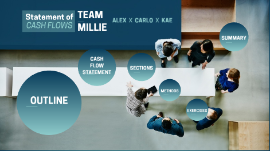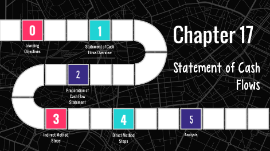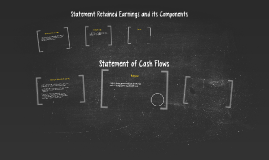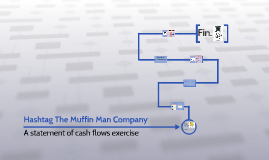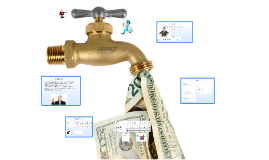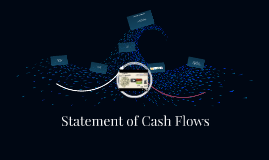Statement of Cash Flows
Transcript: CASH FLOWS ALEX X CARLO X KAE Statement of TEAM MILLIE OUTLINE What is the Statement of Cash Flows? - Definition - Equations - Purpose Sections - Operating Activities - Investing Activities - Financing Activities Preparation Methods - Indirect Method - Direct Method Summary OUTLINE CASH FLOW STATEMENT CASH FLOW STATEMENT DEFINITION CASH FLOW STATEMENT Previously “Flow of funds statement” Shows where cash came from and how it was spent Reports why cash increased or decreased during the period Communicating link between the Income Statement and cash reported on the Balance Sheet CASH FLOW STATEMENT The Cash Flow Statement includes only inflows and outflows of cash and cash equivalent. Cash equivalents consist of short-term, highly liquid investments such as Treasury bills, commercial paper and money market funds. Excludes transactions that do not directly affect cash receipts and payments. Non-Cash activities are reported in footnotes ORGANIZING CFS To compare data from different companies, U.S, generally accepted accounting principles (GAAP) and International Financial Reporting Standards (IFRS) require companies to follow prescribed rules. One of the rules are to organize the statement into secctions that report cash flows. EQUATIONS For Asset accounts Beginning balance + Debits – Credits = Ending balance For Contra-Asset Accounts (Accumulated depreciation) /Liability/Stockholder’s Equity Beginning balance – Debits + Credits = Ending Balance The two equations used when adjustments are needed: PURPOSE PURPOSE Predict future cash flows Evaluate management decisions Predict the ability to pay (for debts and dividends) Most essential to; - Potential Lenders and Creditors - Potential Investors - Company Shareholders - Potential employees/contractors SECTIONS CASH FLOW SECTIONS OPERATING Operating Activities Generate cash inflows and outflows related to revenue and expense transactions that affect the net income. Core business / revenue-generating activities Ex. marketing the products, administering payroll, maintaining facilities Generally, operating activities refer to those that involve current assets and current liabilities. “How much cash did we generate from the daily activities of the business?” Can determine whether a company is profitable or not? Cash activities related to net income. For example, Sales Revenue - Cost of Goods Sold -------------------------- Gross Profit - Operating Expenses -------------------------- Operating Profit/Loss Operating Activities Operating Activities Cash inflows: - Sale of goods or services - Collection of accounts - Interest from borrowers and cash dividends received Cash outflows: - Purchases of merchandise from suppliers - Salaries expense - Marketing expenses - Interest paid to lenders - Income taxes INVESTING Investing Activities Generate cash inflows and outflows related to acquiring or disposing non-current assets such as property, plant, and equipment, long-term investments and loans to another entity. Cash spent on investments in capital assets In general, investing activities include transactions that involve non-current assets. - CAPEX, PPE “Where does the company put its money for long-term purposes?” Cash inflows: Cash sales of property, plant, and equipment Cash sales of equity investments Cash outflows: Purchase of property, plant, and equipment Purchase of equity investments Investing Activities FINANCING Financing Activities Generate cash inflows and outflows related to borrowing from and repaying principal to creditors and completing transactions with the company's ownes. Includes a) Obtaining cash from issuing debt and repaying the amounts borrowed b) Obtaining cash from stockholders shares and repaying dividends. Changes in long-term liabilities and stockholder’s equity Usually associated with long-term liability & equity items Cash inflows: From sale of common stock From issuance of long-term debt (bonds & notes) Cash outflows To stockholders as dividends To redeem long-term debt or reacquire capital To owners as withdrawals Financing Activities METHODS PREPARATION METHODS DIRECT Direct Method Under this method, the income statement is resconstructed on a cash basis from top to bottom. Example: Cash collected from customers is listed instead of revenue Payments to suppliers are listed instead of cost of goods sold Direct Method Lists all of the major operating cash receipts and payments during the period by source Lists where the cash inflows came from, usually customers, and where the cash outflows went, typically employees, vendors, etc. INDIRECT Under this method, the net income is adjusted to a cash basis. It has an advantage over the direct method because it shows the reasons for any differences between net income and net cash by operating activities INDIRECT METHOD 1) Add depreciation charges to net income Basic Equation for Contra-Assets Accounts Beginning balance - Debits + Credits = Ending Balance $300 - $70 + Credits = $500 Credits = $500 - $300








